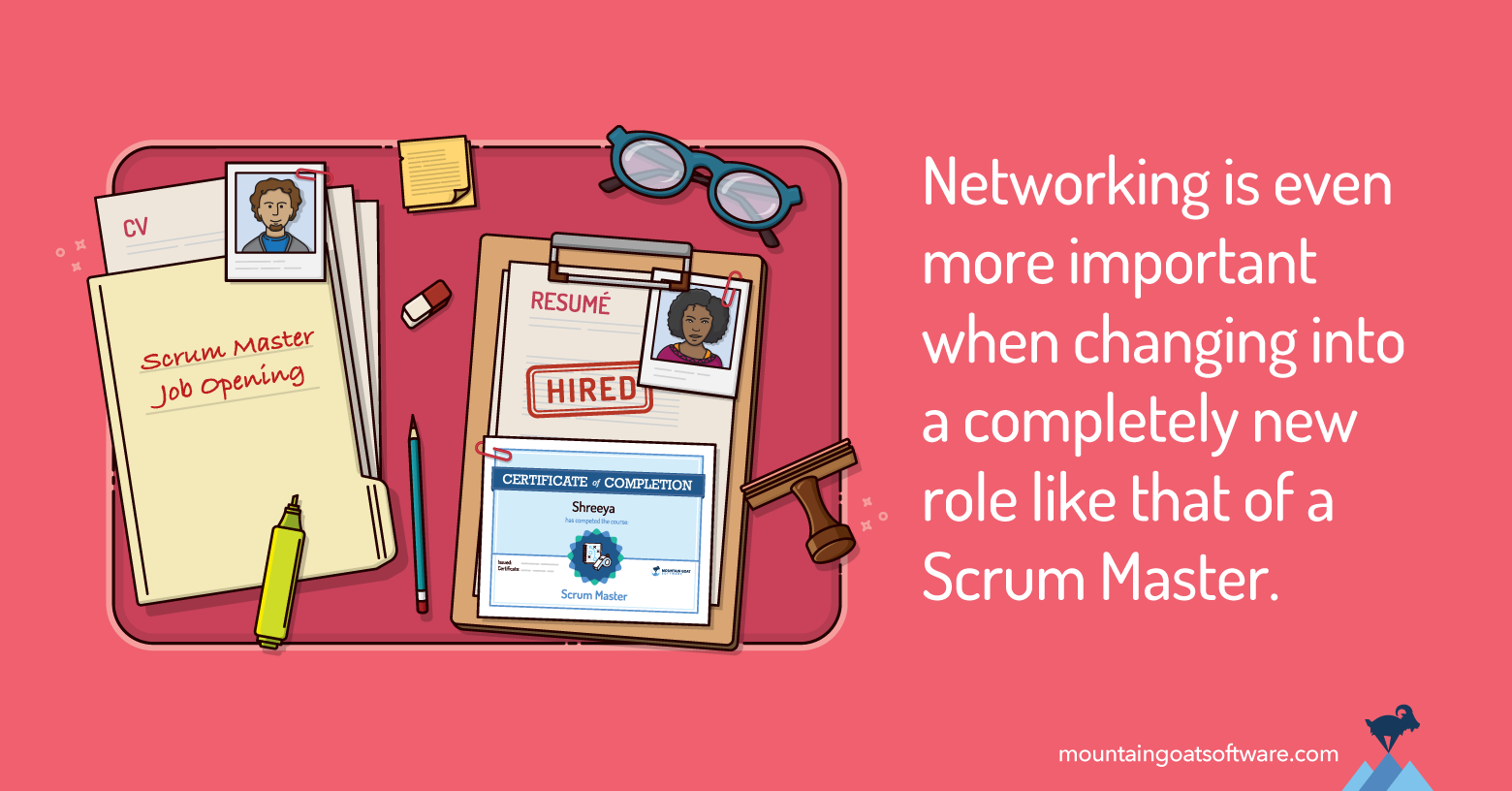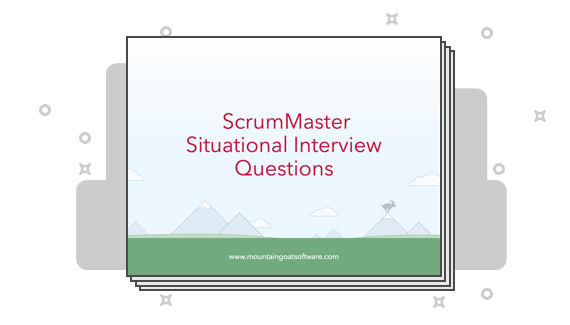Being a Scrum Master can be a fun, exciting and very rewarding career. Being able to look back on a successful project and thinking, “Look at what I helped the team create” is very satisfying.
But, what most newly certified ScrumMasters want to know is how to become a Scrum Master with no experience. In this article, I’ll share seven tips that can help you get that first Scrum Master position, including how to get experience as a Scrum Master even before you land your first gig.
Highlight any Relevant Experience
You may not have any actual Scrum Master experience, but do you have any Scrum or agile experience you can highlight on your resume or LinkedIn profile?
If so, call it out.
For example, were you part of a team that did daily scrum meetings even without being agile? I was. Early in my career, I was a project manager running a very traditional project. My team members and I realized we could very possibly make the very aggressive deadline we’d been assigned—if nothing fell through the cracks for the last month of the project.
Years before daily scrums were a thing, before Scrum even existed, we decided we’d meet every day outside the boss’s office. Within a few days, we’d put up sticky notes listing the work we had remaining. It resembled today’s Scrum boards or kanbans in the way the Altamira cave paintings resemble fine art, but it was a start.
And if I were looking for my first Scrum Master job based on that, I’d say on my resume that I conducted daily scrums for my team on that project.
It should go without saying that you should never lie on your resume, but those most assuredly were daily scrums even if we didn’t know to call them that at the time.
Look for Opportunities with Your Current Employer First
In many cases an excellent first step is to find opportunities to practice at least small parts of agility within your current employer. For example, on a project that isn’t fully ready for agile or isn’t interested in such a big change, try some of the following:
- Introduce the idea of iterations or sprints
- Begin conducting daily scrums
- Periodically demonstrate finished functionality to stakeholders
- Conduct periodic meetings (retrospectives) to find ways to improve collaboration and teamwork
- Add a kanban (task board, Scrum board) in a team’s workspace
- Report periodically on progress using agile approaches such as burndown charts
Introducing small changes like this benefits those projects and gives you the opportunity to call out those experiences on your resume and LinkedIn profile.
Look for Volunteer Opportunities
If you can’t find opportunities to introduce small bits of agility within your current employer, consider looking for volunteer opportunities to do so.
This could be a regional, national or international non-profit whose cause you care about. Or it could be as close by as a child’s school, youth sports team, or your church.
Get creative and find ways to gain experience anywhere in any way you can. I know of at least a handful of people who struggled to get that first position who sought out volunteer opportunities and then leveraged that experience into a full-time Scrum Master position.
Get Certified
While I do teach Certified ScrumMaster courses, I don’t consider those certifications to be proof of any great ability to do the job of Scrum Master. A two-day course cannot be enough to learn all that’s needed to do the job.
But earning a credential that is recognized does indicate two things: a certain base level of knowledge and, more importantly, a willingness to learn and invest in oneself. As an employer, I’d weigh that heavily.
In pursuing a Scrum certification, get yours from one of the credible Scrum training organizations—either the Scrum Alliance (CSM) or Scrum.org (PSM). Those organizations have been around the longest and have certified the most people.
Be careful of other certifying bodies—many could actually harm your chances of getting a job. A resume claiming a certification from the agile equivalent of a diploma mill could be a red-flag to many employers, as it could indicate a lack of judgment on the part of the applicant.
Know that Most Resumes Are Computer Screened First
To find a job as a Scrum Master, you need to make sure your resume gets read. Most employers these days will use software to screen applications. To get past those filters, you want to use all reasonable variations of words and phrases.
For example, if you are applying for a “Scrum Master” position be sure your resume uses the phrases “Scrum Master” but also “ScrumMaster,” both with and without a space so you maximize chances of clearing a computer screening that includes only one of those words.
Perhaps your prospective employer will be screening for experience running daily scrums. Be sure to refer to those as daily scrums, daily stand ups, and daily standups on your resume.
Similarly use both sprint and iteration, burndown and burn down.
Good writing would normally call for consistency. And many years ago I would have looked at a resume that used both Scrum Master and ScrumMaster as being a bit sloppy and in need of better proofreading. But when I see that today, I think, “Aha, here’s someone who's on the ball. They know the trick.”
Network Even More than Normal
It’s often said that most jobs are found through one’s personal networking. And certainly, part of a successful job search (especially when changing into a new field) requires a good dose of luck—being in the right place at the right time.
If networking is necessary when searching for a job like the one you already have, it’s even more important when changing into a completely new role like that of a Scrum Master.
Be sure all your friends and former colleagues know the type of position you’re looking for. But also, do as much networking as you can in local interest or user groups.
You definitely want to participate in local agile groups, such as Agile Denver or Agile Denver-North in my hometown. But, just as importantly, attend meetings of any other groups whose members may work at the type of company you want to join. For example, that could include interest groups on Java, Python, or any other programming language. It could also include product development or project management groups.
Go Out of Your Way to Highlight Your Other Relevant Experience
If everything else is equal, an employer seeking to fill a Scrum Master role will prefer to hire someone with experience as a Scrum Master. Since you don’t have that experience, you need to call out whatever else you can in your background that makes you a good fit for the position.
If you are applying for a Scrum Master job in the financial services industry, for example, do whatever you can to highlight and demonstrate your experience in that industry. Your cover letter and resume should be peppered with vocabulary from that domain.
Without the desirable attribute of prior Scrum experience, you need to do something to make yourself stand out. If you have prior experience in the industry, be sure to call it out. Even if you don’t have experience, demonstrate that you’ve done your research on the industry and company by using the vocabulary in your cover letter.
Be Patient
I want to give you one parting word of advice when following these tips: Be patient. Shifting your career in a new direction will probably take longer than finding your same position in another organization. So, be persistent. It may take time.
But, by following the advice of the seven tips in this article you’ll definitely improve your chances of finding your first Scrum Master position.
Last update: July 11th, 2024









